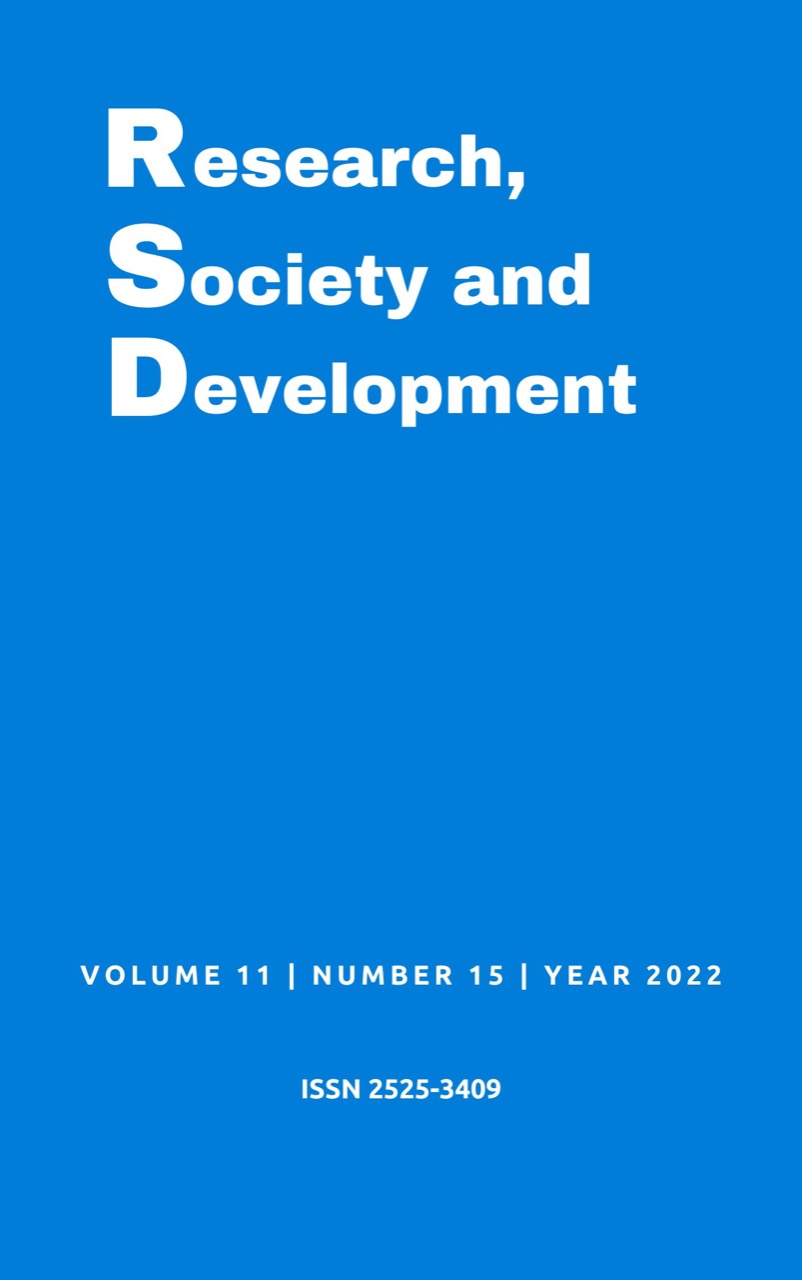Stability evaluation in a bleaching formulation
DOI:
https://doi.org/10.33448/rsd-v11i15.36979Keywords:
Pharmacotechnics; Stability; Skin depigmentation.Abstract
Introduction: Assessing the stability of products before marketing them is of great importance. Cosmetics that present problems in organoleptic, physicochemical and microbiological stability are failing to comply with basic quality requirements and can pose risks to consumer health. Objective: To evaluate the stability of a whitening formulation developed and manipulated in a pharmacy in Cascavel - PR as a function of time. Methodology: Evaluation of the formation through preliminary stability and accelerated stability studies, based on centrifugation tests, thermal stress, ice/thaw cycle. During the tests the organoleptic and physicochemical characteristics were evaluated. The tests were carried out according to the methodology proposed by Anvisa. Results: The formulation remained unchanged after centrifugation. In the thermal stress test, changes were observed in viscosity from 40ºC and changes in color and odor after 50ºC. In the ice/thaw cycle, the organoleptic characteristics changed from time 7 onwards and were more evident at time 21. The pH value changed in all tests performed. Conclusion: Taking into account the stability analyzes carried out, it can be observed that the whitening formulation does not have stability. C and that the pharmacy put a warning label to keep the product sheltered away from heat to avoid possible changes in it, and that further studies should be carried out in order to determine the validity of the formulation.
References
Allen Jr, L. V., Popovich, N. G., & Ansel, H. C. (2013). Formas Farmacêuticas e Sistemas de Liberação de Fármacos-9. Artmed Editora.
Anfarmag. Associação Nacional de Farmacêuticos Magistrais (2014). Manual de Estabilidade: pH de ativos de uso tópico.
Brasil. (2004). Guia de Estabilidade e Produtos Cosméticos. Brasília, DF. https://www.gov.br/anvisa/pt-br/centraisdeconteudo/publicacoes/cosmeticos/manuais-e-guias/guia-de-estabilidade-de-cosmeticos.pdf/view
Brasil. (2008). Guia de Controle de Qualidade de Produtos Cosméticos. Uma Abordagem sobre os Ensaios Físicos e Químicos. Brasília, DF. https://www.gov.br/anvisa/pt-br/centraisdeconteudo/publicacoes/cosmeticos/manuais-e-guias/guia-de-controle-de-qualidade-de-produtos-cosmeticos.pdf/view
Aquino, J. S., Carmello, L. S., Felipe, D. F., & dos Santos, R. A. M. (2013). Estudo da Estabilidade de Géis Contendo Vitamina C, Manipulados em Farmácias da Cidade de Maringá-PR. Saúde e Pesquisa, 6(3).
Barzotto, I. L., Oliveira, S. M. M., Tavares, B., & Dallabrida, S. (2009). Estabilidade de emulsões frente a diferentes técnicas de homogeneização e resfriamento. Visão Acadêmica, 10(2).
Batistuzzo, J. A. (2002). Formulário Medico-Farmaceutico. (4a ed.), Pharmabooks.
Boarolli, J. T., & Bender, S. (2019). Avaliação da estabilidade e concentração do xampu de cetoconazol manipulado em função do tempo comparado a um xampu comercial. FAG Journal of Health, 1(1), 189-202.
Cunha, A. R., Silva, R. S., & Chorilli, M. (2009). Desenvolvimento e avaliação da estabilidade física de formulações de xampu anticaspa acrescidas ou não de extratos aquosos de hipérico, funcho e gengibre. Revista Brasileira de Farmácia, 90(3), 190-195.
Engenharia das Essências (2022). Polawax. Ficha Técnica. https://engenhariadasessencias.com.br/loja/materias-primas/137-polawax-nf-contratipo.html
Ferreira, A. D. O. (2000). Guia prático da farmácia magistral. In: Guia prático da Farmácia Magistral (pp. 320-320).
Isaac, V. L. B., Cefali, L. C., Chiari, B. G., Oliveira, C. C. L. G., Salgado, H. R. N., & Correa, M. A. (2008). Protocolo para ensaios físico-químicos de estabilidade de fitocosméticos. Revista de Ciências Farmacêuticas básica e aplicada, 29(1).
Infinitypharma. (2021). Alfa arbutin – aespigmentante. https://infinitypharma.com.br/wp-content/uploads/2022/01/Alfa-arbutin.pdf.
Oliveira, D. D. J., Souza, M. R. V., Diógenes Júnior, F. M., Sousa, J. D. P. S., Neto, B. M., & Meirelles, L. M. A. (2019). Controle de qualidade de cremes à base de hidroquinona adquiridos em farmácias magistrais: uma análise comparativa. Brazilian Journal of Surgery and Clinical Research, 29(1), 01-13.
Mauboussin, M. (2016). Aulton delineamento de formas farmacêuticas. Elsevier Brasil.
Milan, A. L. K., Milão, D., Souto, A. A., & Corte, T. W. F. (2007). Estudo da hidratação da pele por emulsões cosméticas para xerose e sua estabilidade por reologia. Revista Brasileira de Ciências Farmacêuticas, 43, 649-657.
Maia, A. M. (2002). Desenvolvimento e avaliação da estabilidade de formulações cosméticas contendo ácido ascórbico. (Doctoral dissertation, Universidade de São Paulo).
Netz, P. A., & Ortega, G. G. (2014). Fundamentos de físico-química: uma abordagem conceitual para as ciências farmacêuticas. Artmed Editora.
Previdello, B. A. F., Carvalho, F. R. D., Tessaro, A. L., Souza, V. R. D., & Hioka, N. (2006). The pKa of acid-base indicators and the influence of colloidal systems. Química Nova, 29, 600-606. https://doi.org/10.1590/S0100-40422006000300032
Polytechno. (2005). Ficha técnica. http://www.laboratorionutramedic.com.br/site/public_images/produto/37feaf4e7ffe93d70fe38c4ff814e7e0.pdf
Purifarma. (2022). Alpha arbutin. Ficha técnica. http://www.purifarma.com.br/Arquivos/Produto/Alpha%20Arbutin.pdf.
Ramos, L. C., de Lima, T. L. C., & De Souza, G. O. (2021). Desenvolvimento e controle de qualidade de formulação Anti-Age com óleo de Vitis sp. Research, Society and Development, 10(14), e08101421904-e08101421904. https://rsdjournal.org/index.php/rsd/article/view/21904.
Rebello, T. (2019). Guia de produtos cosméticos. Editora Senac São Paulo.
Siqueira, J. C. D. (2017). Avaliação da estabilidade de uma emulsão cosmética cold cream contendo diferentes tipos de ceras. (Bachelor's thesis). Univates. https://www.univates.br/bdu/items/5041ef85-14be-4495-8749-f631c4a2f145
Downloads
Published
How to Cite
Issue
Section
License
Copyright (c) 2022 Emanuelli dos Santos; Suzana Bender

This work is licensed under a Creative Commons Attribution 4.0 International License.
Authors who publish with this journal agree to the following terms:
1) Authors retain copyright and grant the journal right of first publication with the work simultaneously licensed under a Creative Commons Attribution License that allows others to share the work with an acknowledgement of the work's authorship and initial publication in this journal.
2) Authors are able to enter into separate, additional contractual arrangements for the non-exclusive distribution of the journal's published version of the work (e.g., post it to an institutional repository or publish it in a book), with an acknowledgement of its initial publication in this journal.
3) Authors are permitted and encouraged to post their work online (e.g., in institutional repositories or on their website) prior to and during the submission process, as it can lead to productive exchanges, as well as earlier and greater citation of published work.

